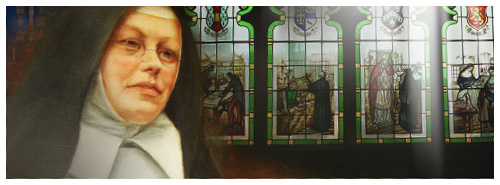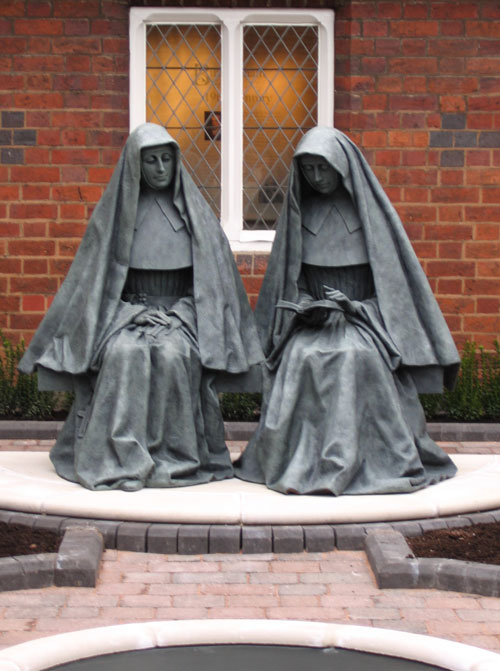![[thumbnail] Barbara Jeffery rsm](../_uploads/resources/authors/136-fcdf6373/8203CBC8-A61F-A672-F7DE1A2696735FD8.jpg)
Juliana Hardman
A biography written by Barbara Jeffery rsm
The first Reverend Mother of St Mary’s Convent, Handsworth was Juliana Hardman. She came from a staunch Catholic background and her family had their roots in Lancashire, a county renowned for its Catholicity. John Hardman Senior, Juliana’s father, went into the metal button trade and set up his own business in Birmingham with a partner Thomas Lewis. John married three times during his life and had families with his first two wives. It was with his second wife, Lydia Wareing that John had two daughters who both became Sisters of Mercy, Mary and Juliana.

Juliana Hardman First Superior of Handsworth, Stained Glass Windows in Catherine’s Oratory
Juliana was born on 26 April 1813 and it appears that she was probably taught at home until she was 12 years old. Her mother died when she was only 3 years old and her father married his third wife, Barbara Sumner when Juliana was just 13. Juliana went to Caverswall Castle in Staffordshire to be educated by the Benedictine nuns and in 1826 Bishop Walsh confirmed her. It seems that it was Bishop Walsh who was instrumental in the Sisters of Mercy coming to Handsworth. In a letter dated February 4 1840 Bishop Walsh wrote to John Hardman to say that he had one grand plan and that was to approach Catherine McAuley for a foundation in Birmingham. In April 1840 The Morning Register newspaper reported:
“The plans etc of the building are by the highly gifted Pugin, and have been much admired by all who have seen them. The convent is intended to receive twenty of the Sisters and also to accommodate thirty poor orphans whom they will take under their care. The chief expense will be borne by that noble-minded inhabitant of Birmingham, John Hardman, Esq., whose never failing liberality in the course of charity and religion can only be rewarded in a better world. Four ladies are about to proceed immediately to Dublin, to go through their novitiate there and as soon as professed to return to Birmingham. We understand that Miss J Hardman, a daughter of the generous founder of the convent is one of the happy number” (Morning Register, Wed April 22nd 1840)
So it was that Juliana set off for Dublin with her three companions, Anne Wood, Lucy Bond and Elizabeth Edwards, on 29th April 1840. After a few months in Baggot Street, they were clothed on August 10th, receiving the names, Juliana, Xavier, Vincent and Cecilia. They made their Profession on 19 August 1841 along with Sr Vincent Whitty, Sister Francis Creedon and Sr Justina Fleming, a niece to Bishop Anthony Fleming of Newfoundland. The newly professed then returned to Birmingham along with, among others, Sr Liguori Gibson who was a novice for the Liverpool foundation. Mother Catherine McAuley and Mother Cecilia Marmion accompanied them. They arrived in Handsworth about noon on 21 August 1841. On 6 September 1841 Bishop Walsh appointed Juliana as the first Superior of the community. Catherine McAuley, no doubt, gave her wholehearted support during her month’s stay and took the opportunity to visit Mr Hardman who was ill at the time and who resided in his house just opposite the convent.
The orphans were taken in and visitation of the poor and sick was started under Juliana’s watchful care. In 1843 the House of Mercy was begun and in December 1843 Juliana must have been delighted to welcome her older sister Mary into the community. She became Sr Mary of the Cross Hardman in April 1844. August 1844 saw a much harder parting for both Juliana and Mary as their father John Hardman died on 10th. He had been an exemplary father to them and had encouraged them in their vocations.
After Mr Hardman’s death, his son, John Hardman Junior took up the mantle of support for the work of Mercy to continue. It was he who suggested a Church should now be built to serve the Catholics of the area and he headed the list of subscribers with a donation of £1,000. John Hardman Junior had made the acquaintance of the architect Pugin in 1838 and he was to work very closely with him from this time on, eventually adding stained glass manufacturing to his achievements in 1845. In August 1846 the first stone of the new Church was laid.
Towards the end of 1849 there was great excitement in the convent as Mother Vincent Whitty paid a short visit to St Mary’s, on her way to Ireland to seek for new postulants for the Brisbane foundation. We can only imagine what fond reminiscences she and Juliana must have shared about their Profession Day eight years beforehand and how they must have marvelled at where their respective paths had led them.
In 1851 another branch house opened – Maryvale – and Juliana’s own sister, Mary of the Cross Hardman became its first Reverend Mother. However, Mary of the Cross was not to live long in such idyllic settings, for in 1854 she became ill and gradually grew weaker, making a short rally at the beginning of March 1855 but suddenly failing and dying on 15 March. She had not quite reached 50 years of age when she died and this surely must have been a heavy blow for Juliana to bear.
However work still continued and in 1858 a new move was made on the education scene when, encouraged by Bishop Ullathorne, the Sisters had built a large Boarding School for middle class children. It was opened in January 1859 and ran until 1884, supplying an education for this group of children.
In August 1866 the community celebrated the 25th anniversary of the foundation of their convent as well as the Professions of their first four Sisters, Juliana, Xavier, Vincent and Cecilia. Sadly Cecilia had died in 1847 and Vincent in 1864 but the surviving two founder members, Juliana and Xavier were present to celebrate such a special milestone. For months beforehand the whole convent had been busy with preparations for the event. The Sisters’ spare moments were given up to painting, Illuminating and sewing, each one determined to offer her best for the celebration. The Cloisters were coloured and inscriptions were painted over the archways and appropriate mottoes were painted for every doorway and over each cell hung the name of the Sister’s patron saint.
The next year 1867, Mother Juliana had another painful parting to make as her brother, John Hardman Junior died in Clifton, near Bristol. His eldest son, John Bernard Hardman was to continue his father’s generous sponsorship and support of the community.
In 1880 Mother Juliana received an unusual present from the House of Mercy children – it was a carriage! Even though it was a second-hand one it provided much amusement to the community.
In 1882 the Sisters took on the Visitation of the Workhouse Infirmary. In February 1884 Bishop Ullathorne asked Mother Juliana if she would take up the education of the Catholic children from the Workhouse.
 However, Juliana herself was nearing her end. She died on March 24 1884 and her Solemn Requiem was held on 27th. Juliana had been Reverend Mother for thirty-five years of her religious life – a testament indeed to the trust the sisters put in her and her leadership of the community. At the time of the Golden Jubilee of St Mary’s Convent in 1891, a Sister who had known Juliana well gave this description of her:
However, Juliana herself was nearing her end. She died on March 24 1884 and her Solemn Requiem was held on 27th. Juliana had been Reverend Mother for thirty-five years of her religious life – a testament indeed to the trust the sisters put in her and her leadership of the community. At the time of the Golden Jubilee of St Mary’s Convent in 1891, a Sister who had known Juliana well gave this description of her:
“As a Superior, our dear Mother Juliana was highly esteemed by the Community and by the Superiors of the other Houses in the Diocese who looked to her for counsel in all their difficulties. She was most gentle but very firm; no one could argue or think of her changing her decision once given. She was very sparing in giving commands and full of charity and motherly affection for the Sisters."
Juliana had lived as a religious for 43 years and was Superior for 35 of those years. She had professed 59 Sisters and made four Foundations – to Nottingham, St Anne’s in Birmingham, Wolverhampton and Maryvale, also in Birmingham. She had the House of Mercy built in 1844, the Church in 1847, the first Poor Schools in 1850, St Joseph’s Boarding School in 1858 and the new Poor Schools in 1872.
Surely here we have a picture of a true daughter of Catherine McAuley.
Image: Bronze life size sculpture of Catherine McAuley (left) and Juliana Hardman (right) in the prayer garden at St Mary's Convent.
Sculpture by Philip Jackson CVO DL MA FRBS

